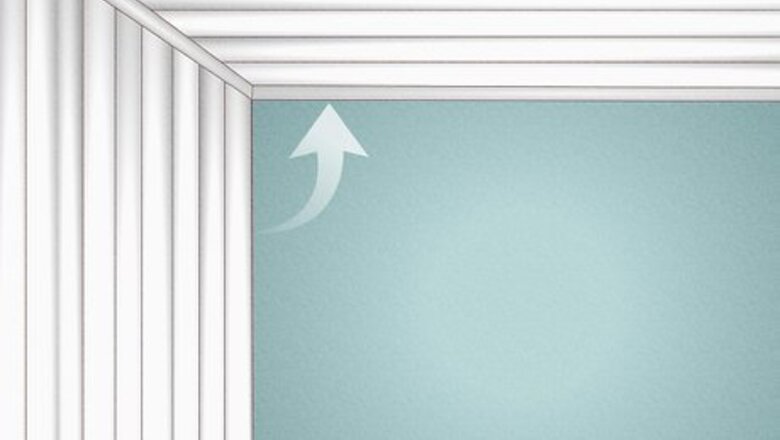
views
Can I use wall panels for a ceiling?
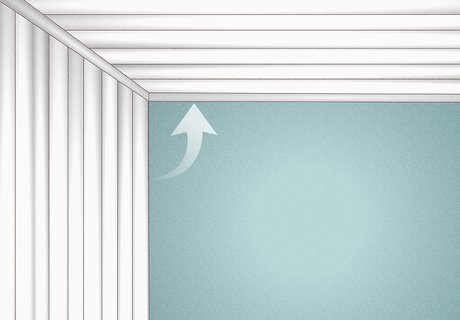
Yes, you can use the same plastic panels for walls and ceilings. Since PVC is lightweight, you can easily take any panel made for a wall and put it on your ceiling instead. If there’s a wall panel that you like but don’t have the space for in your home, putting on the ceiling could be a good compromise. The 2 main types of panels to use on your ceiling are cladding, which create a seamless look on unfinished ceilings, and decorative tiles, which are thinner, attach to finished ceilings, and can have three-dimensional decorative designs on them. Some plastic panels have 3D patterns while others are flat and look similar to hardwood. Get whatever style you prefer or whatever matches the aesthetic of the room.
How do I measure PVC for a ceiling?
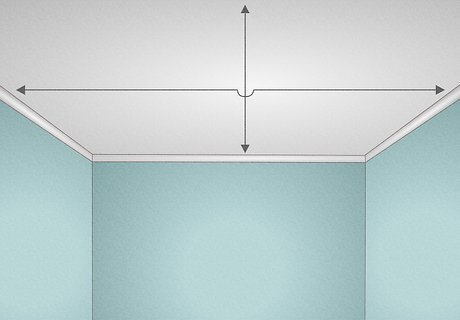
Find the dimensions of the room to calculate the ceiling area. Take your measurements from the centers of each wall rather than taking it from one corner to another. Otherwise, you might get an inaccurate measurement if your walls aren’t perfectly square. Use a tape measure to find the length and the width of the room. Then, multiply the 2 numbers together to get the total ceiling area that you have to cover. For example, if your room is 8 by 10 feet (2.4 m × 3.0 m), then the total area is 80 sq ft (7.4 m). If you don’t have a square or rectangular room, then measure it in separate rectangular sections. Then, add the section areas together. For example, if you have a breakfast nook attached to your kitchen, find the kitchen’s area first and add the area of the nook.
Then, divide the area by the panel’s size to find how many you need. Measure the length and width of a single panel that you want to use for your room. Multiply your 2 measurements to find the area of the panel. After you divide the room area by the panel area, the answer is how many panels it takes to cover your entire ceiling. For example, if the panel has an area of 4 square feet (0.37 m) and the room is 80 sq ft (7.4 m), you would divide 80 / 4 = 20 tiles. Get 1 or 2 extra tiles to account for any mistakes or tiles you might have to cut.
Calculate the depth of an outer border around your PVC tiles. Decorative tiles look more balanced and uniform if you have cut pieces along the outer edge. Measure the length of your room and round it down to the nearest even number of feet. Subtract the adjusted measurement from the actual length and add 2 feet (61 cm). Then divide the number by 2 to find the size of your border tiles. For example, if your room is 15 feet (4.6 m) long, round it down to 14 feet (4.3 m). Subtract: 15 - 14 = 1 foot (30 cm). Add 2 feet (61 cm): 1 + 2 = 3 feet (0.91 m). Divide by 2: 3 / 2 = 1 ⁄2 feet (0.46 m). So your border tiles would be 1 ⁄2 feet (0.46 m) wide around the edge of your tiles.
How do I cut plastic ceiling panels?

Use a fine-toothed saw for cladding. Plastic cladding has tongue-and-groove joints and looks similar to long wooden boards. Transfer the room’s width measurement onto the cladding and mark it with a pencil and straightedge. Clamp the cladding to your work surface and use your short, shallow strokes with your saw to make a straight cut. Avoid using a wide-toothed saw since it will leave rough edges on the ends of your cladding.
Work with a large pair of scissors for thin plastic tiles. Decorative tiles are a lot thinner than cladding, so they’re a lot easier to cut without special tools. Draw the line you want to cut on the backside of the tile and cut along it with some heavy-duty scissors or a pair of tin snips. You can also use scissors to cut out holes for ceiling vents and other fixtures that need to come through your tiles.
Cut out spots for lighting fixtures with a hole saw. If you have recessed lighting, measure the distance from the wall to the lighting fixture. Transfer your measurement onto your ceiling panel so you know where to make your hole. Use a hole saw that’s about the same diameter as the fixture to make your cut through the panel. You can cut holes for fixtures before or after you install the panels on your ceiling.
How do I fit PVC cladding?
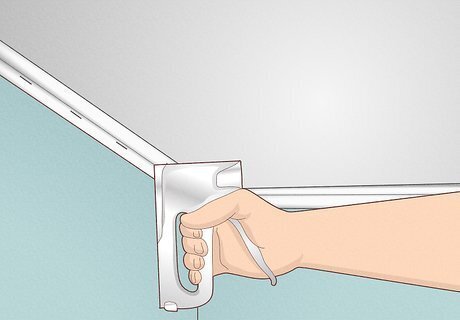
Cut and install the trim along the edges of your ceiling. The trim pieces have grooves that support the ends and edges of your cladding so it’s less likely to sag or fall down. Measure the length of each wall in your room from the top corners and cut the trim to size with a pair of tin snips. The trim pieces for each wall are the same, so it doesn’t matter where you cut them as long as they’re the proper lengths. Hold the trim against the edge of your ceiling, and either use a nail or staple gun to secure it to each of the joists, which should be visible if your ceiling isn’t currently finished. The trim pieces may come with the panels, but you may need to buy them separately. Cladding uses a tongue-and-groove system, which means it looks seamless once you install it on your ceiling. Cladding gives your room a clean appearance, but its work best for unfinished ceilings.
Slide the first panel against the wall and staple it down. Cut the protruding tongue off of the first piece of panel with your saw. Fit the ends of the panel into the trim pieces on the long sides of the room so the panel doesn’t fall down. Then, guide the side of the panel you just cut into the trim piece on the short side of your room until it butts up to the wall. Finally, staple the panel’s groove into each of the joists. The trim will hide the cut edge of the first panel, so it’s okay if it still looks a little rough.
Keep adding panels until you reach the other end of the room. Measure the width of the room just in front of the panel you just installed since it may vary. Cut the next piece of panel to the right size and slide it into the end trim pieces. Push the new panel’s tongue tightly against the previous panel’s groove to give your ceiling a nice, seamless look. Always staple the panel to the joists before installing the next one. The last panel might be a tight fit, but you can bend it slightly to help get it into the right position.
How do I attach PVC ceiling panels?

Attach decorative panels to finished ceilings with silicone adhesive. Any water-based adhesive will work for installing your panels. Put nickel-sized dots of adhesive evenly along the raised surfaces on the back of the panel. Press the panel against your ceiling so it adheres tightly. When you place the next panel, overlap the edge with the previous panel so you have a seamless, uniform design. If you had to cut out any spots for vents or light fixtures, place a bead of adhesive around the cut edge so it doesn’t come loose later on. PVC ceiling panels are shaped like tiles, so they’re really nice if you want a decorative or repeated pattern going over your entire ceiling. These tiles are cheaper, but you have to apply them to a finished ceiling or use a drop-down grid. Place your first tile starting in the center of your ceiling and build outward towards the edges. That way, your ceiling design looks balanced and you leave room for a border.
Set deep or coffered panels into a metal grid for a drop-in ceiling. If you’re updating a drop-in ceiling, you can just use the metal grid that you already have installed. Otherwise, you can install one yourself. Just set the panel in a space on the grid so the metal supports hold it in place. You don’t need any special fasteners or adhesive, so it makes installation really quick.
Can I paint a plastic ceiling?
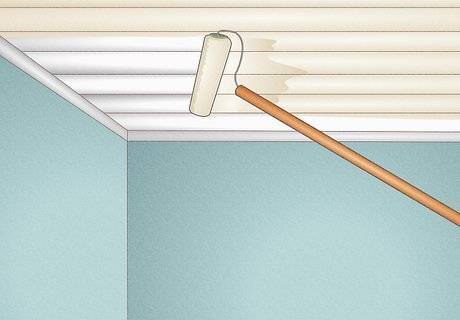
Yes, you can paint your ceiling using a long-handled roller. Choose a roller that has a ⁄2 in (1.3 cm) nap so you can get into the grooves of the ceiling. Roll the paint in the same direction as your paneling so you don’t leave any marks on it. Apply 1–2 coats of paint so the panels have a uniform color. Avoid using a roller with a longer nap since it could leave a texture on your ceiling.
Is a PVC ceiling heat-resistant?

PVC can handle temperatures up to 130 °F (54 °C). PVC ceilings work well in just about any room, but they can’t tolerate hot temperatures from direct sunlight or above a stovetop. If your PVC gets too hot, it might start sagging and ruin the look of your ceiling. PVC is fire-retardant, but it will still sag and melt if it has prolonged exposure to heat sources.
















Comments
0 comment